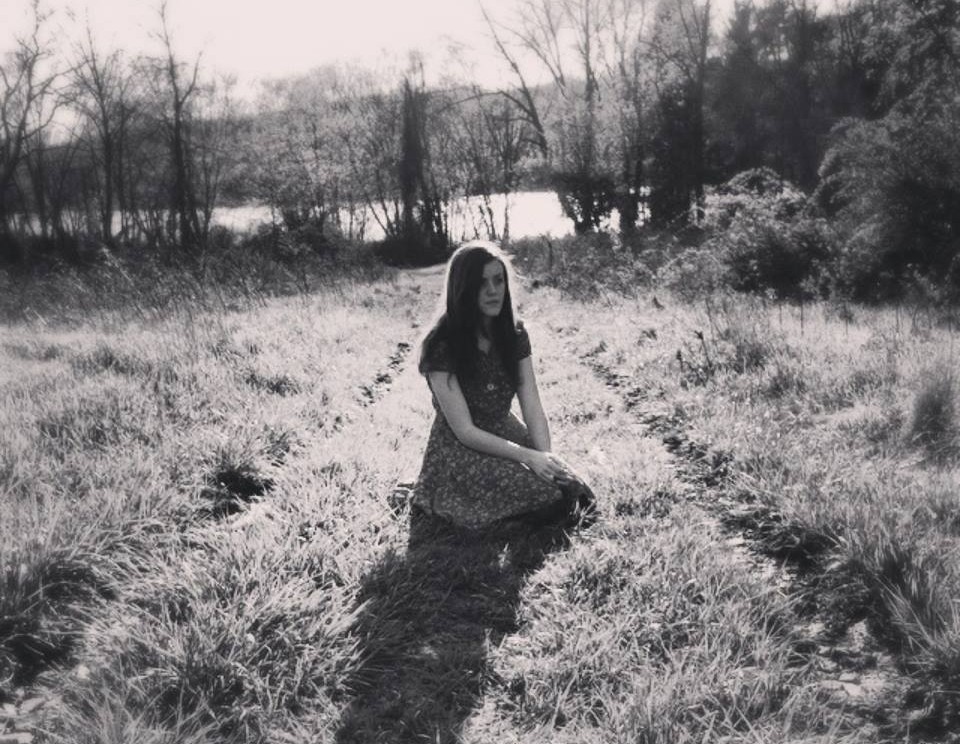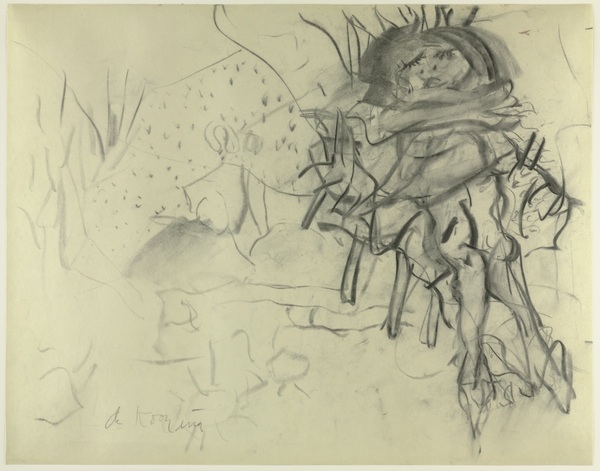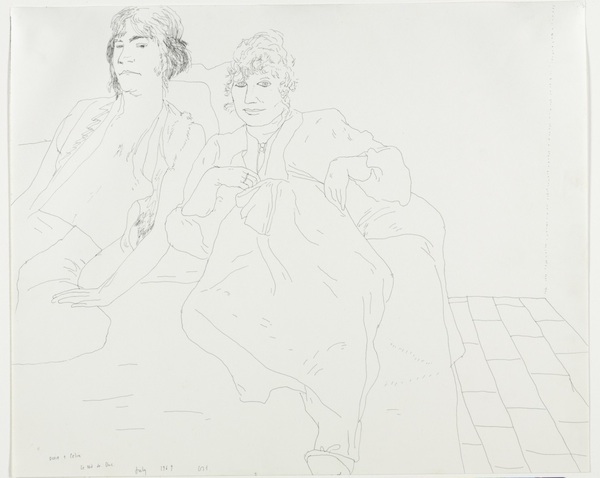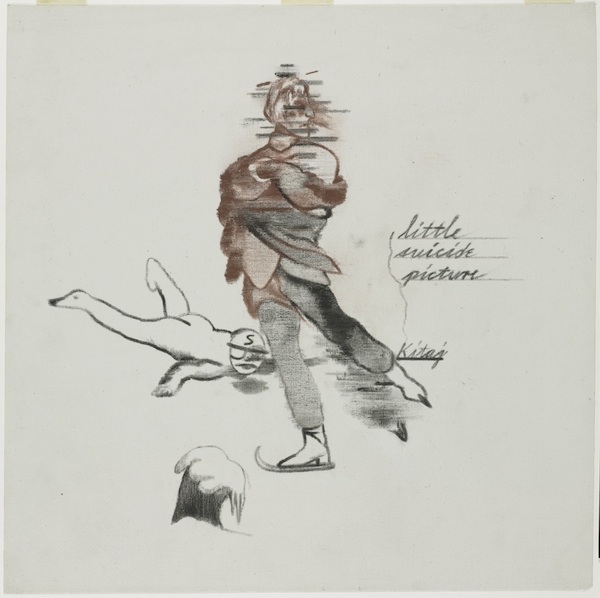Brian Young Reviews “On Paper: Figure Drawings from the Benesch Collection” at the Baltimore Museum of Art
This modest-sized exhibition of drawings, found on the BMA’s third-floor gallery, consists of ten works by Elmer Bischoff, Peter Blake, Reg Butler, Willem de Kooning, Philip Grausman, Nancy Grossman, David Hockney, R. B. Kitaj, Eduardo Paolozzi, and Robert Rauschenberg. The show, drawn from the 140 international drawings in the Benesch collection, was organized by Ann Shafer, Associate Curator for Prints, Drawings, and Photographs for the BMA.
Aside from the unifying subject matter and provenance, the sheets date from the 1955 to 1972, and, in terms of execution, the works are largely absent of color, with Kitaj and Rauschenberg’s sheets as the exceptions. The result is a tightly focused show that explores the physical and psychological tensions that the figure offered to those artists who swam, at times, against the powerful currents of abstraction and minimalism during those decades.
If one concedes that this show has less to do with physiognomy and more to do with the human condition, this is underscored in Nancy Grossman’s tactile pair of sheets executed with a lithographic crayon. By way of background, the artist is best known for her wood sculptures covered in leather, an interest that was sparked much earlier during her childhood exposure to the garment industry. Grossman pursued her interest in fiber media during here study at the Pratt Institute (New York), where she earned a BFA. There, she studied under Richard Lindner, a prominent figurative artist whose mother owned a corset business.
In addition, Grossman has remarked that her work generally reflects, “. . . the bondage of my childhood” and may allude to “inappropriate sexual contact from a male relative in her adolescents.” In her Untitled work from 1972, the artist has depicted a figure pulled, unnaturally, to the left and radially from the upper and lower right. Because the figure is bound by a corset and leather belts, one surmises that some part of the anatomy would appear to surrender. Until then, we are left with suspense, reinforced by the rich and fluid pigment. This piece reflects the totality of the Grossman’s background beginning from childhood and moving through her strongest professional and artistic influences.
David Hockney’s drawing also strongly reflects his life events. Beginning around 1965 or 1966, he began to devote much of his artistic energy to painted and drawn portraits of friends, including numerous double portraits. While he found working in pen to be rather laborious, he thought highly of the medium and pointedly remarked, “I mean if you want to work in line I think that it is the loveliest medium of all.”*
Seeing Ossie and Celia at Le Nid de Duc (1969) at the BMA is particularly satisfying, as Hockney’s technique is a worthy successor to the linear approach mastered by Picasso (during his neo-classical phase in the early 1920s) and Matisse, two artists well represented in the museum’s works on paper collection. Like his predecessors, Hockney gives weight and volume with a delicate use of line. Through pose and gesture, he provides a glimpse of the intimacy and aloofness of the two figures.
For me, the Hockney and Grossman sheets provide the bookends for the Benesch selection. Hockney’s work is modest in scale and uses a deft and economical approach to build a quiet encounter. Grossman’s work is the largest in the show with bold gestures and a rich medium to create an image of uncertainty. The other eight drawings in this exhibition fall in between the aforementioned pair.
Like Hockney, De Kooning’s countless drawings of the aggressive female owe a distant debt to Picasso, but primarily to the latter’s earliest Cubist work going back to the monumental Les Demoiselles d’Avignon of 1907. De Kooning’s line in the BMA sheet builds up certain forms such as the downturned face, but liberally employs erasure and spontaneous marks that deconstruct the figure. Adding to the purposeful discord, the work is notably imbalanced and weighted to the right. Comparing the De Kooning to the Grossman and Hockney, one might remark that the De Kooning is a stylistic and psychological bridge between the other two.
Peter Blake’s dreamlike April with Pipalo and Star King might be the surprise hit of “Figure Drawings.” Blake, who is best known for his crowded figural collage for the Beatle’s 1967 hit album, Sgt. Pepper’s Lonely Hearts Club Band, shows Pipalo with her two imaginary friends. While the central image is the epitome of control and economy – slightly unexpected traits from the famous pop artist – there is a delicate counterbalance that owes a debt to surrealism. The figure’s left ponytail, for example, is largely formed while the right is merely suggested. Providing a rough symmetry, her right eye is a bit wider than the other. The shirt is a tour de force of ribboned, monochromatic stripes. Throughout the face and mouth, Blake creates form with intermittent patches of graphite. The eyes are frozen with a touch of white, opaque watercolor. In the end, Blake has created an economical study of a figure caught somewhere between eternal innocence and the momentary.
Ronald Brooks (R.B.) Kitaj was a lifelong friend of David Hockney and their drawings from the same year (1969) make for a striking comparison. While Hockney’s double portrait is a snapshot, Kitaj’s work is an enigmatic commentary on personal tragedy. Little Suicide Picture is a reference to the suicide of the artist’s wife of 16 years. In terms of composition, the piece is a fluid, yet ironic masterpiece. The figure’s left leg is extended in a pose distinctively exclusive to ice skating. The right leg provides the direction as the figure glides effortlessly past the viewer. In the background, to the skater’s right is, presumably, the outline to the body of Kitaj’s wife. The red pastel torso and the intersected face run counter in spirit to the sweeping motion. In the end, Suicide Picture is that rare work that cannot escape its biographical underpinnings.
Elmer Bischoff’s work, #14 Artist and Model, is also from 1969 and leads one to wonder if the figurative work of ’69 could form the nucleus for a different BMA show. That aside, Bischoff’s work is typical for the West Coast’s figurative artists from the 1960s and 1970s. When New York artists were dominating the national scene with their dedication to abstraction, Bischoff, David Park, Richard Diebenkorn, and others doubled down on the figure. In Bischoff’s use of crayon, rubbing, wash and paint, this work reminds us that drawings may attain the richness of painting. The artist shows himself sketching to the right while the nude model opens up in a traditionally erotic pose. Yet, the hanging lamp and other mundane features reduce the piece to a glimpse of the artist’s working method.
Eduardo Paolozzi’s work is one of those rare pieces that has changed with the times. In our current environment, This Man with a Camera (1955) now appears as collaged forerunner to the ubiquitous “selfie.” Paolozzi, like Warhol and the somewhat forgotten Richard Hamilton, understood the power of mass media, pop culture and found imagery. Paolozzi has often been credited with creating the first pop art work, I Was a Rich Man’s Play Thing, from 1947. In the BMA’s piece, we see the quintessential element of Paolozzi’s larger output: he has created a hybrid form between man and machine. On top of that, a camera has been added for a delightful twist. The playful nature of a bionic robot taking pictures is perfectly executed in a child-like series of lines that crudely builds form. Shading is non-existent. In a bit of further interplay with the viewer, the lens cap is shuttered, closing off the notion that one is being photographed.
If the less-than-traditional execution is not everyone’s cup of tea, then the two nudes by Reg Butler and Philip Grausman should satisfy the urge for classical draftsmanship that owes an ultimate debt to J.A.D. Ingres and his highly trained contemporaries.
Taken as a whole, this show hardly makes its presence known. But for connoisseurs, this selection of work is the perfect antidote to the trend among galleries and museums to grow in scale, complexity, and visual firepower.
On Paper: Figure Drawings from the Benesch Collection is up through September 14, 2014 at the Baltimore Museum of Art.
Author Brian Young is curator for the Arts Program and adjunct assistant professor of art history at the University of Maryland University College in Adelphi, Maryland.
* Quote from ‘David Hockney: An Interview (with Mark Glazebrook)’ in David Hockney, Paintings, Prints and Drawings 1960-1970, Whitechapel Art Gallery exhibition catalogue, 1970, p. 12











